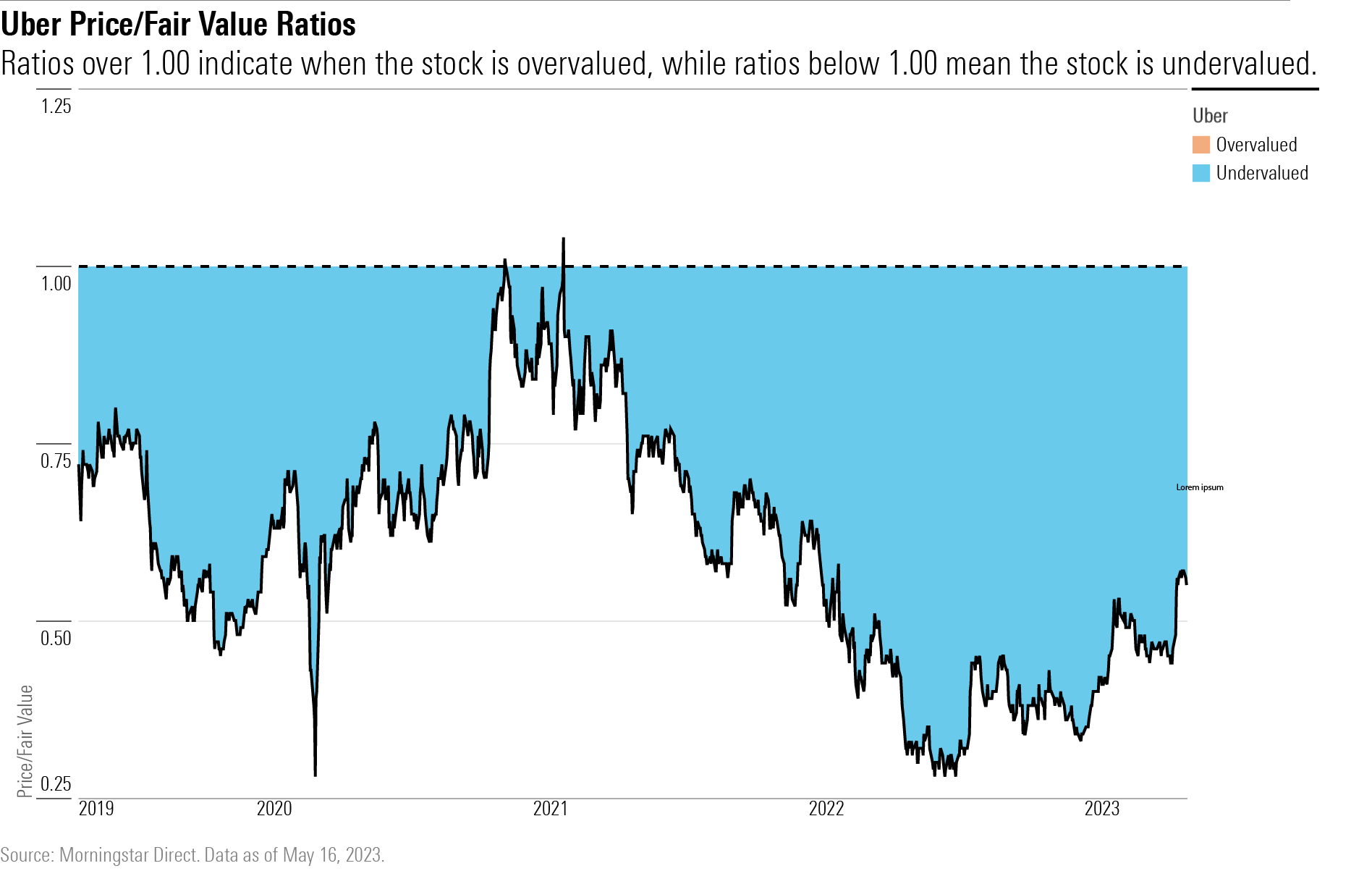Is Uber Stock a Buy After Earnings?
With stronger top-line growth and margin expansion, here’s what we think of Uber’s stock.

Uber Technologies UBER released its first-quarter earnings report on May 2. Here’s Morningstar’s take on what to think of Uber’s earnings and stock.
Uber Stock at a Glance
- Fair Value Estimate: $68
- Morningstar Rating: 4 Stars
- Morningstar Uncertainty Rating: Very High
- Morningstar Economic Moat Rating: Narrow
What We Thought of Uber’s Earnings
We are maintaining our $68 fair value estimate for narrow-moat Uber Technologies. The network-effect economic moat source is coming to fruition as demand on the firm’s platform increases while consumer and driver acquisition costs decline. Together, these factors are driving top-line growth and margin expansion. The moat is also creating more pressure on the few competitors that remain, including Lyft in the United States.
Uber yet again generated free cash flow during the first quarter, and it is considering returning cash to shareholders, demonstrating confidence that it will expand margins. In our view, Uber shares remain attractive.

Fair Value Estimate for Uber Stock
Our $68 fair value estimate represents an enterprise value of 4 times our 2023 revenue estimate. We project that Uber’s revenue could grow an average of 17% annually over the next five years.
We expect revenue to grow faster than portions of Uber’s cost of revenue, including hosting, transaction processing, and insurance costs, which will result in gross margin expansion. With the network-effect economic moat source, we think Uber should also be able to increase revenue at a faster pace than selling, general, and administrative costs (especially in the sales and marketing lines) while spending relatively less on operations and support costs.
Read more about Uber’s fair value estimate.

Morningstar Economic Moat Rating
In our view, Uber’s core ride-sharing platform benefits from network effects and valuable intangible assets in the form of user data. We think these maintainable competitive advantages will help Uber become profitable and generate excess returns on invested capital. For this reason, we assign Uber a narrow moat rating.
As the number of drivers has increased, the timeliness and reliability of the service has improved, boosting the number of users, which in turn attracts more drivers, all of which indicate a network effect.
While Uber has benefited nicely from network effects, we don’t believe it benefits from customer switching costs. In our view, the ride-hailing industry lacks barriers to entry or exit. Both customers and drivers can easily switch to Lyft or other competing platforms, while customers also have other transportation options like taxis and public transit.
In our view, Uber’s ride-hailing network effect has also helped the firm tap into other markets and generate additional revenue streams. An example is the delivery market, where the company has gained traction with its Uber Eats service.
As Uber benefits from its network effect, we think it gains access to valuable intangible assets in the form of user data, which we suspect helps the firm improve its services and increase its vehicle capacity utilization.
Read more about Uber’s moat rating.
Risk and Uncertainty
Uber faces intense competition in the United States from Lyft, which has gained market share. In addition, it remains possible that Lyft will out-innovate Uber to emerge as the leading ride-hailing provider. At the same time, the firm’s increased gathering of driver and rider data may increase its environmental, social, and governance risk around data privacy and security.
Other regulatory issues may also serve to inhibit Uber’s network effect. Concerns include whether Uber will have to pay a minimum amount to each driver or courier per trip. In our view, lack of compensation and/or benefits also constitute a human capital ESG risk, which could lead to drivers jumping to other platforms. We note that both dominating firms in the U.S., Uber and Lyft, are likely to demand higher take rates.
Read more about Uber’s risk and uncertainty.
UBER Stock Bulls Say
- Uber’s position in the autonomous vehicle race could equalize gross and net revenue if it no longer needs to pay drivers.
- Pressure to pay a minimum amount per trip to its contracted drivers could create a barrier to entry for smaller players, helping Uber in the long run.
- Uber’s aggregation of multimodal offerings could drive in-app stickiness, making the firm a one-stop shop for all transport needs.
UBER Stock Bears Say
- The development of autonomous vehicles, especially Google’s Waymo, could eliminate the need for existing ride-hailing platforms, driving Uber and Lyft out of business.
- Ride-hailing is still a relatively new industry, which leaves plenty of room for new regulations that could hurt Uber.
- Uber’s public perception has suffered in recent years because of data breaches, a culture of sexual misconduct, and internal racial discrimination issues.
This article was compiled by Muskaan Hemrajani.
Get access to full Morningstar stock analyst reports, along with data and tools to manage your portfolio through Morningstar Investor. Learn more and start a seven-day free trial today.
The author or authors do not own shares in any securities mentioned in this article. Find out about Morningstar’s editorial policies.


:quality(80)/cloudfront-us-east-1.images.arcpublishing.com/morningstar/TGMJAWO4WRCEBNXQC6RFO5TOAY.png)
:quality(80)/cloudfront-us-east-1.images.arcpublishing.com/morningstar/JUWC2VJUKBCG5P3KVQJCHL5QSQ.jpg)
:quality(80)/cloudfront-us-east-1.images.arcpublishing.com/morningstar/JD5KSEJFLNFLJA5XRS6YK2O24Q.jpg)